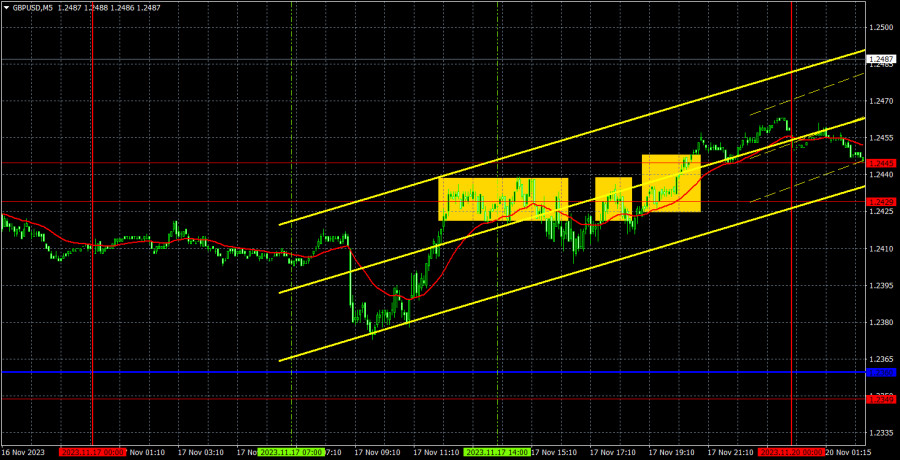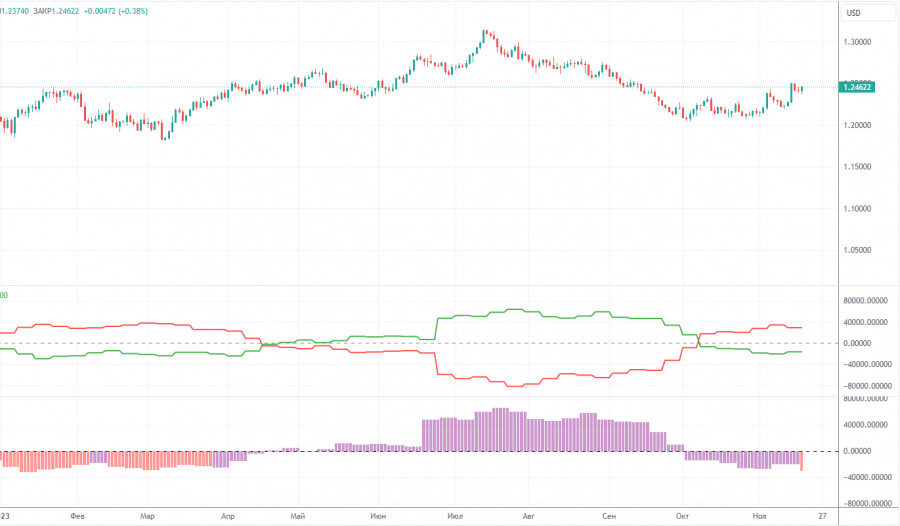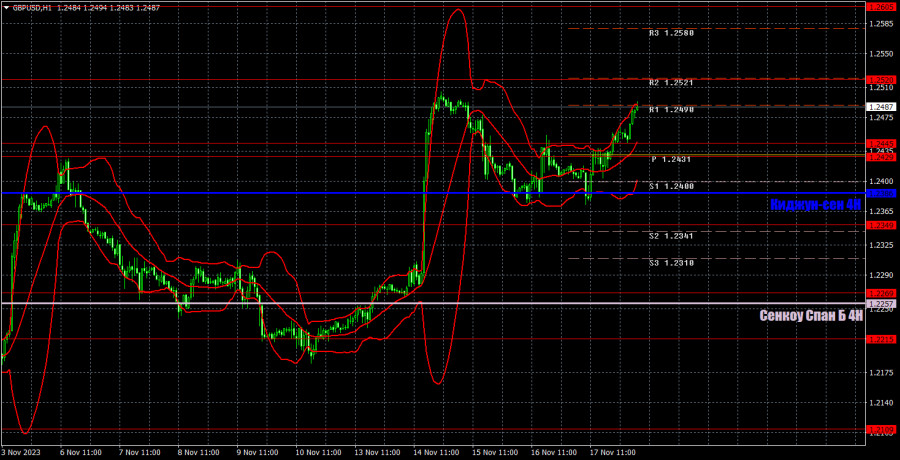

GBP/USD bounced bullishly on Friday, despite trading negatively during the European session, which was logical both from a fundamental and technical standpoint. First, the UK retail sales report turned out to be weaker than forecasted. Secondly, the pair did not correct against the strong 250-pip rally on Tuesday. However, the downward movement did not last long. Within an hour, the British pound resumed its upward movement. By the end of the day, the British currency gained another 70 pips for no apparent reason. Today, GBP/USD is moving higher even though it is clear that there was no news overnight or over the weekend that could have triggered its growth. Basically, the pair has no logical reason to rise.
Speaking of trading signals, there were three and all of them left much to be desired. At the beginning of the US trading session, the price rebounded from the 1.2429-1.2445 area twice, but in both cases, it failed to drop by 20 pips. Traders were somewhat lucky that the pair could not surpass the specified area almost until the end of the day. Therefore, the trade could be closed with minimal losses or even without any at all. The price only managed to surpass the 1.2429-1.2445 area when the trading day was about to close, but it was already too late to execute this buy signal.
COT report:
COT reports on the British pound also align perfectly with what's happening in the market. According to the latest report on GBP/USD, the non-commercial group closed 6,100 long positions and 10,200 short ones. Thus, the net position of non-commercial traders decreased by another 4,100 contracts in a week. The net position indicator has been steadily rising over the past 12 months, but it has been firmly decreasing over the past three months. The British pound is also losing ground. We have been waiting for many months for the sterling to reverse downwards. Perhaps GBP/USD is at the very beginning of a prolonged downtrend or in the middle of a strong correction. At least in the coming months, we do not see significant prospects for the pound to rise, and even if we're currently witnessing a corrective phase, it could persist for quite some time.
The British pound has surged by a total of 2,800 pips from its absolute lows reached last year, which is an enormous increase. Without a strong downward correction, a further upward trend would be entirely illogical (if it is even planned). We don't rule out an extension of an uptrend. We simply believe that a substantial correction is needed first, and then we should assess the factors supporting the US dollar and the British pound. A correction to the level of 1.1844 would be enough to establish a fair balance between the two currencies. The non-commercial group currently holds a total of 57,500 longs and 73,800 shorts. The bears have been holding the upper hand in recent months, and we believe this trend will continue in the near future.
Analysis of GBP/USD 1H
On the 1H chart, GBP/USD continues to form another corrective phase. Last week, it failed to surpass the Kijun-sen line, so there are no technical reasons for the pair to fall. On the contrary, the market indicates that despite the fundamental background and the corrective status of the movement, it is actually ready to buy. In our opinion, the current upward movement lacks a solid foundation. Therefore, the only option is to follow the market, go with the trend, and consider buying.
As of November 20, we highlight the following important levels: 1.1927-1.1965, 1.2052, 1.2109, 1.2215, 1.2269, 1.2349, 1.2429-1.2445, 1.2520, 1.2605-1.2620, 1.2693, 1.2786. The Senkou Span B (1.2257) and Kijun-sen (1.2386) lines can also be sources of signals. Signals can be "bounces" and "breakouts" of these levels and lines. It is recommended to set the Stop Loss level to break-even when the price moves in the right direction by 20 pips. The Ichimoku indicator lines can move during the day, which should be taken into account when determining trading signals. The illustration also includes support and resistance levels that can be used to lock in profits from trades.
On Monday, we will highlight Bank of England Governor Andrew Bailey's speech, who will likely address the topics of inflation and monetary policy. The latest inflation report has been quite resonant but leaves the BoE chair room only for dovish comments.
Description of the chart:Support and resistance levels are thick red lines near which the trend may end. They do not provide trading signals;
The Kijun-sen and Senkou Span B lines are the lines of the Ichimoku indicator, plotted to the 1H timeframe from the 4H one. They provide trading signals;
Extreme levels are thin red lines from which the price bounced earlier. They provide trading signals;
Yellow lines are trend lines, trend channels, and any other technical patterns;
Indicator 1 on the COT charts is the net position size for each category of traders;
Indicator 2 on the COT charts is the net position size for the Non-commercial group.